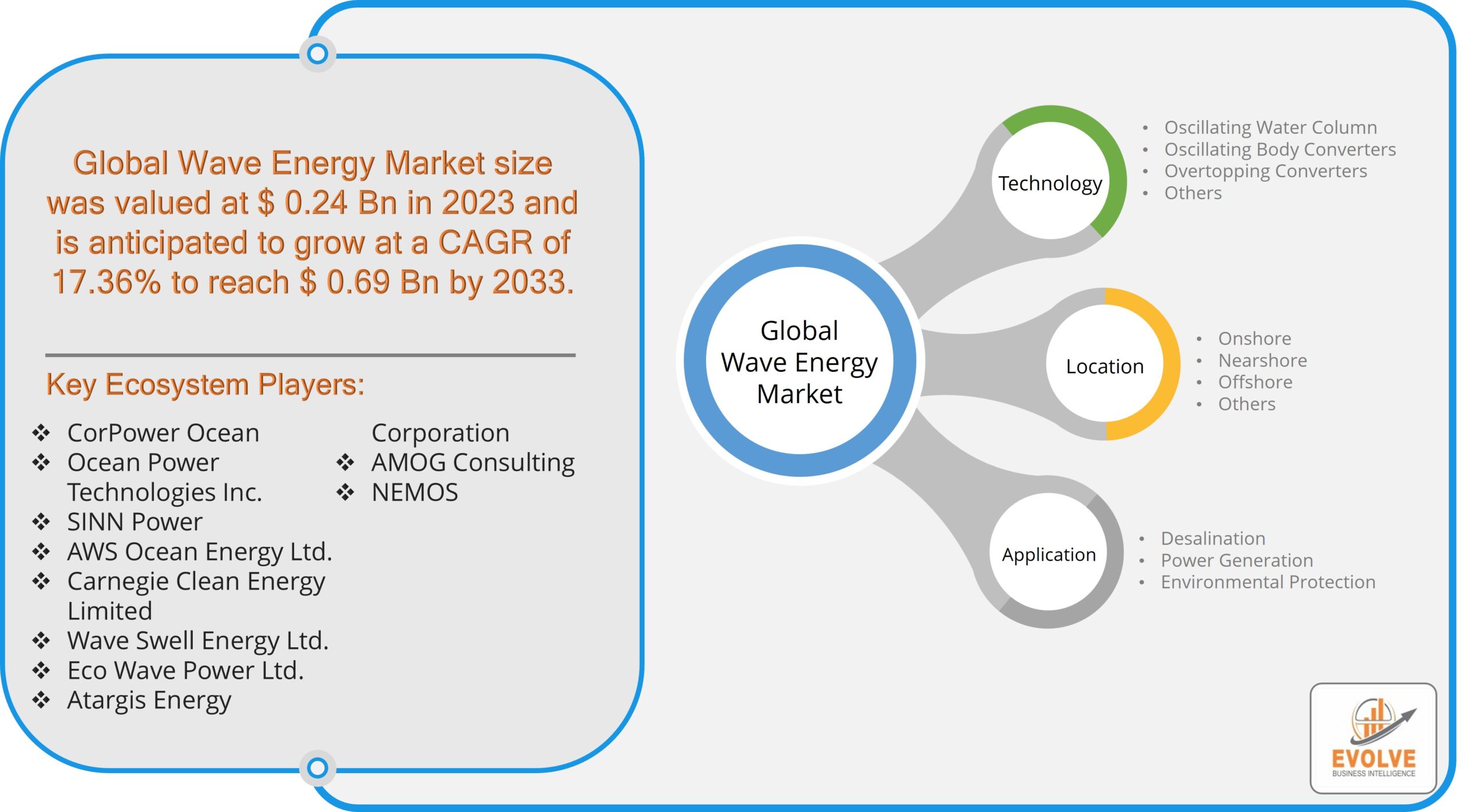Wave Energy Market Is Estimated To Record a CAGR of Around 17.3%
Evolve Business Intelligence has published a research report on the Global Wave Energy Market, 2023–2033. The global Wave Energy Market is projected to exhibit a CAGR of around 17.36% during the forecast period of 2023 to 2033.
Evolve Business Intelligence has recognized the following companies as the key players in the global Wave Energy Market: CorPower Ocean, Ocean Power Technologies Inc., SINN Power, AWS Ocean Energy Ltd., Carnegie Clean Energy Limited, Wave Swell Energy Ltd., Eco Wave Power Ltd., Atargis Energy Corporation, AMOG Consulting, and NEMOS.
For More Information: https://evolvebi.com/report/wave-energy-market-analysis/
Global Wave Energy Market Highlights
The Global Wave Energy Market is projected to be valued at USD 0.69 Billion by 2033, recording a CAGR of around 17.36% during the forecast period. The Wave Energy Market refers to the sector of the energy industry focused on harnessing the energy generated by ocean waves to produce electricity. This market involves the development, production, and deployment of technologies that convert the kinetic energy of waves into usable electrical power.
The wave energy market aims to provide a renewable and sustainable energy source, contributing to the reduction of greenhouse gas emissions and dependence on fossil fuels. Governments around the world are increasingly investing in renewable energy, and wave energy has the potential to be a major part of the future energy mix.
The COVID-19 pandemic had significant impacts on the Wave Energy Market. The pandemic caused delays and interruptions in the development and deployment of wave energy projects due to supply chain disruptions, restrictions on travel, and shutdowns of manufacturing facilities. Economic uncertainties and financial constraints during the pandemic led to challenges in securing funding and investment for new-wave energy projects. Many investors became cautious, affecting the flow of capital into the sector.
R&D activities in wave energy technology faced setbacks due to reduced workforce availability, restricted access to laboratories, and disruptions in testing and prototype development. The overall market uncertainty and fluctuations in energy demand during the pandemic led to a shift in priorities for some stakeholders, potentially impacting the long-term planning and commitment to wave energy initiatives. The pandemic also accelerated the adoption of digital technologies and remote monitoring, which could benefit the wave energy sector by enhancing operational efficiency and reducing costs.
Segmental Analysis
The global Wave Energy Market has been segmented based on Technology, Location, and Application.
Based on Technology, the Wave Energy Market is segmented into Oscillating Water Column, Oscillating Body Converters, Overtopping Converters, and Others. The Oscillating Water Column segment is anticipated to dominate the market.
Based on Location, the global Wave Energy Market has been divided into the Onshore, Nearshore, Offshore, and Others. The Nearshore segment is anticipated to dominate the market.
Based on Application, the global Wave Energy Market has been divided into Desalination, Power Generation, and Environmental Protection. The Power Generation segment is anticipated to dominate the market.
For More Information: https://evolvebi.com/report/wave-energy-market-analysis/
Regional Analysis
The Wave Energy Market is divided into five regions: North America, Europe, Asia-Pacific, South America, and the Middle East, & Africa. North America has several research initiatives and pilot projects, particularly in the U.S. Pacific Northwest and Canada’s west coast. The focus is on developing and testing new technologies. Supportive policies in certain states, such as California, and the potential for significant wave energy resources on both coasts provide growth opportunities.
Europe is a leader in wave energy research and deployment, with several pilot projects and commercial installations. The European Union has strong policies and funding programs supporting renewable energy. In the Asia Pacific region, Australia has substantial wave energy potential and is actively exploring wave energy projects. Japan and South Korea are also investing in research and pilot projects. High wave energy potential in coastal areas, growing interest in renewable energy, and governmental support are key drivers in this region.
In the Latin America region, Chile has one of the highest wave energy potentials in the world and is exploring wave energy projects. Brazil is also evaluating its wave energy resources. Significant wave energy resources and an increasing focus on renewable energy provide growth potential, though investment and development are still in the early stages. In the Middle East and Africa region, South Africa has some wave energy potential and is beginning to explore its options for renewable energy integration. Emerging interest in diversifying energy sources and addressing energy security challenges offer growth opportunities, though development is currently limited.


